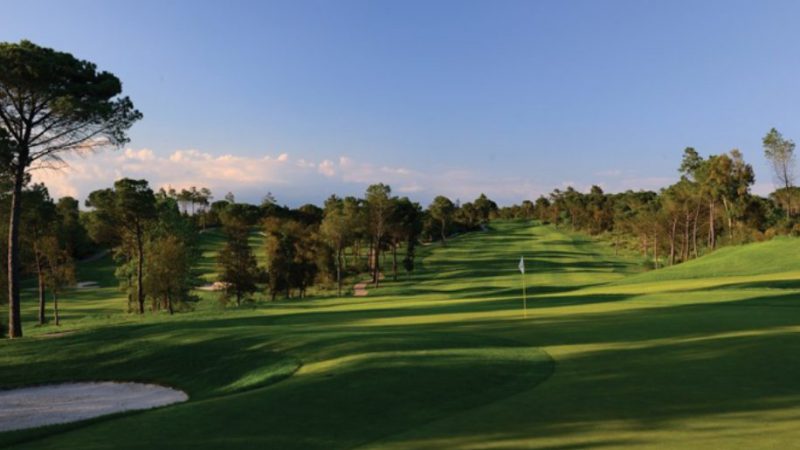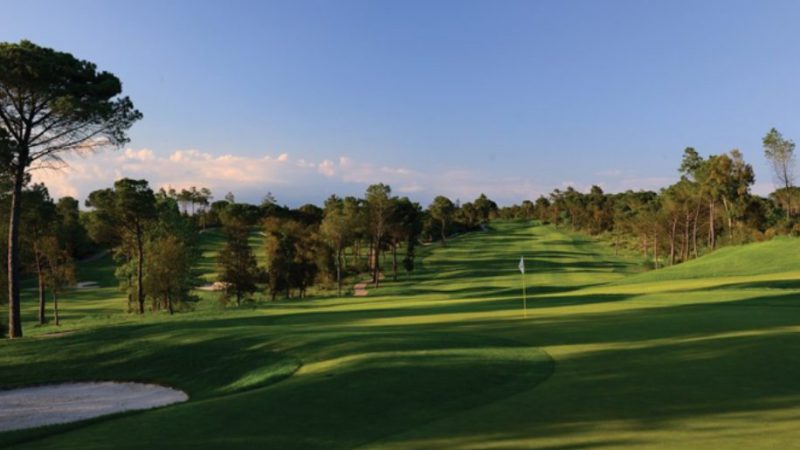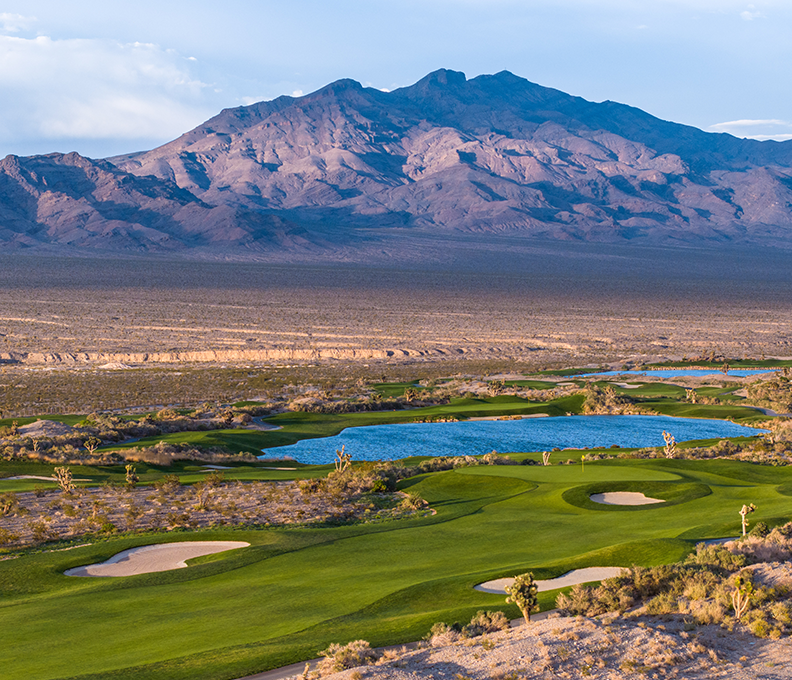Homage to Catalonia
The PGA Catalunya resort has two of Spain’s top golf courses, plus a five-star hotel with striking modernist architecture.
September 30, 2017


You don’t need to have fabulous views for golf, but it can help take your mind off how you’re playing. A round of golf is often described as “a good walk spoiled”, but with rolling fairways, mature forests surrounding the course, frequent lakes and then the Pyrenees on the horizon, even hooking your ball into an ornamental lake causes only a moment’s displeasure. Your mindful game may be spoiled though if you inadvertently cause the ball to skip along the top of the water, and then get a cheer from a neighbouring green (as happened to me). Yet it would be a shame to let one bad shot ruin perfect moments such as this.
Set in mature forests about 20 minutes’ drive from Girona, perhaps the most successful aspect of the PGA Catalunya development is that it disguises how close it is to everything else. Well connected by road and rail to Girona to the north and Barcelona to the south, both of which have international airports, the 300-hectare site was first conceived as a location for a future F1 track.
When that didn’t work out (the track was subsequently built in Montmelo near Barcelona), the plan was for a golf course to be developed to host the Ryder Cup in 1997. Two courses were planned and eventually built – the Stadium championship course and the Tour course. Delays meant that in the end the Ryder Cup went to Valderamma in 1997, but the courses and the surroundings are outstanding. They benefit from having been planned together, but also from landscape design by two outstanding course architects – Angel Gallardo and Neil Coles.
Like most modern golf course developments, the plan was to sell real-estate around the property. There was a four-star Melia hotel on site, and the prospect of many apartments, townhouses and villas. But more than a decade later in 2007-8, Spain had more than half a million residential units around golf courses planned or for sale – and little prospect of many of them being sold. At PGA Catalunya, the decision was made to do things a little differently, by insisting on all development being modernist in design; this alludes to the area’s associations with modern art, and with modernity generally. The so-called “Dali Triangle” of the surrealist artist’s three star attractions are at nearby Figueres, Portlligat and Pubo, and Catalonia was also the home of Picasso for many years. The result is that unlike the majority of recreational and residential developments, the estates look distinct,although all have clean white lines and lots of glass. The buildings fit with one another so when walking or jogging around the resort, or taking bikes out for the day, or playing either of the courses, the clusters of buildings appear to be all of a set, even though they were designed separately.
Three architectural agencies were brought together to create a brand playbook for developers to follow, with the detailing even going down to the type of gardens to be planted and the forbidding of fencing so that each property is a part of the overall development. The gardens lead straight down on to the golf courses. The resort has 24-hour gated security at the entrance, for those worried about safety.
If you stay at the 145-room Hotel Camiral, you benefit from a recently completed €33 million renovation of the old Melia hotel to fit in with the modernist aesthetic. Every room and public area has been transformed under designer Lazaro Rosa-Violan, who is also responsible for Barcelona projects such as Soho House, the Cotton House hotel and the new Edition. The three-storey lobby atrium of the rejuvenated Camiral has windows overlooking the swimming pools, golf courses, villas and the Pyrenees beyond; light floods into the building. There are huge walls of wooden drawers with the names of local flowers on them, a three-storey mirror-backed bookcase and lots of comfortable seats where you can flop down to stare at the decoration and the view. It’s a stunning lobby area, and sets the scene for a re-positioning of the hotel, the golf courses and the real-estate. It is five-star luxury, and as far away from the traditional, outdated perception of golf as can be imagined.
Golf resorts face a double challenge today. Many do not project a modern enough image, and they are suffering a drop in playing numbers in many markets. Golf has never been fashionable, but it has long been aspirational, reason enough for all those real estate developments beginning with the golf course. Today’s time-strapped executives find it difficult to justify time on the golf course, while those with the time for a half day to spare, prefer Lycra and heading out on expensive bicycles. To appeal to a new generation of golfers, while at the same time pleasing their families, more than just a golf course is required. At PGA Catalunya, a wellness resort is being planned alongside the hotel, plus vineyards, a manmade recreational lake, an equestrian centre, and football pitches (footballers love playing golf, since it’s one sport they can enjoy without the risk of injury).
In the meantime, the Hotel Camiral is a relaxing place, with excellent service, and modern rooms refurbished to the highest standards. Those on the pool side have balconies, while rooms at the back overlook the small car park, practice ground and then those forests and mountains. There’s a choice of restaurants, from the Clubhouse Bistrot with fabulous views, to 1477 fine-dining restaurant. There are meeting facilities, providing the venue for several high-spirited groups while we were there, although the place is so large we hardly noticed them. Finally, there are those wealthy enough to buy one of the properties here – which will be capped at 400 units, whether townhouses, villas or apartments. It can be fun working out who these multi-millionaire owners are, but once you’re on the golf course, everyone is equal and subject to the vagaries of their swing or putting touch on the day.
THE COURSES
Both were designed by Angel Gallardo and Neil Coles, and each offers different challenges. Both courses make the most of the rollling landscape, mature forests, and the views of the Pyrenees on the horizon.
Stadium Course
The banking allows stadium-like views for up to 30,000 spectators. This course has many undulating holes and greens where water comes into play. It is narrower and more challenging than the Tour course, yet still possible for handicap players to enjoy. The Stadium hosted the Sarazen World Open in 1999, which was won by Thomas Bjorn, and the Spanish Open in 2000. It is ranked the number-one course in Spain, number three in continental Europe, and named among the World’s Top 100 by Golf World magazine.
Tour Course
Formerly called the Red course and opened in 2005, this is ideal for resort play, with a similar feel but wider fairways and more forgiving approaches to the greens. It is nevertheless championship standard, and co-hosted the European Tour’s Qualifying School Final Stage, alongside the Stadium course in 2008, 2009 and 2010.
In addition there are also two golf academies – the Sergio Garcia, which aims to train the next elite golfers and, for the rest of us, the PGA Catalunya Golf Academy, led by head pro Enric Lopez.




